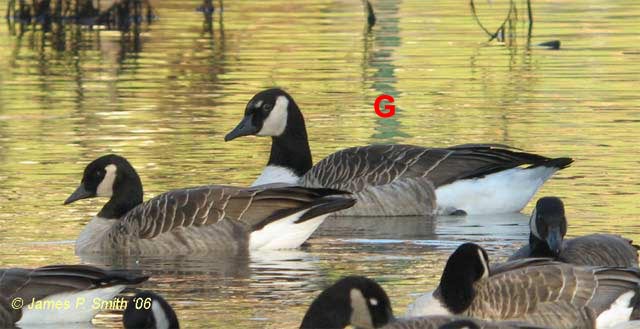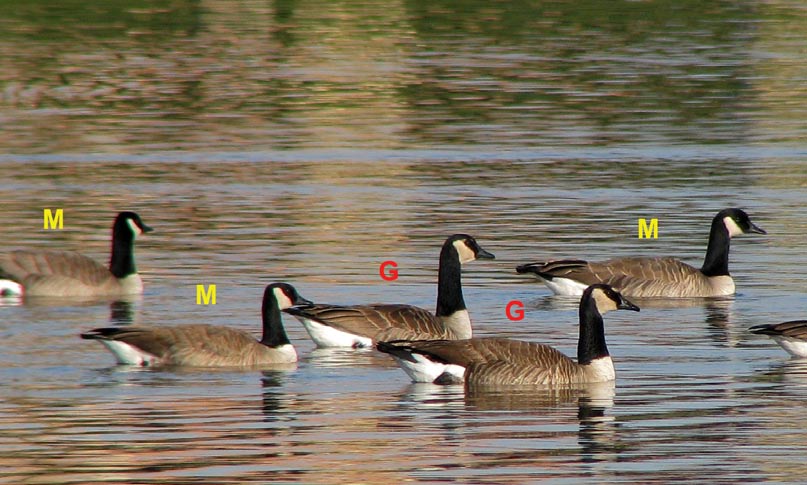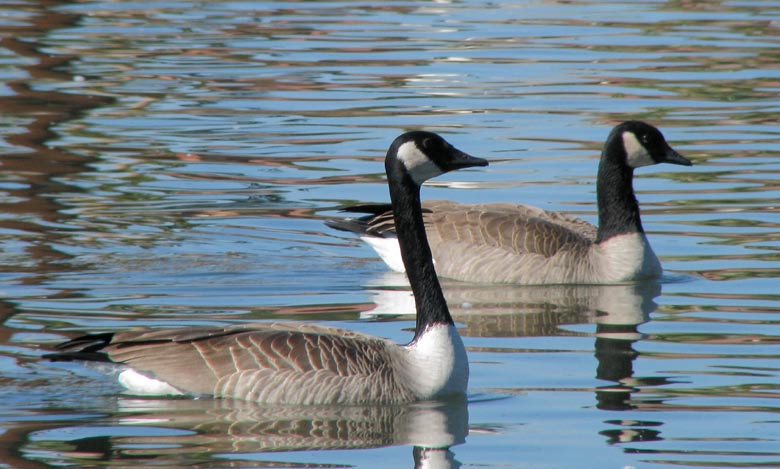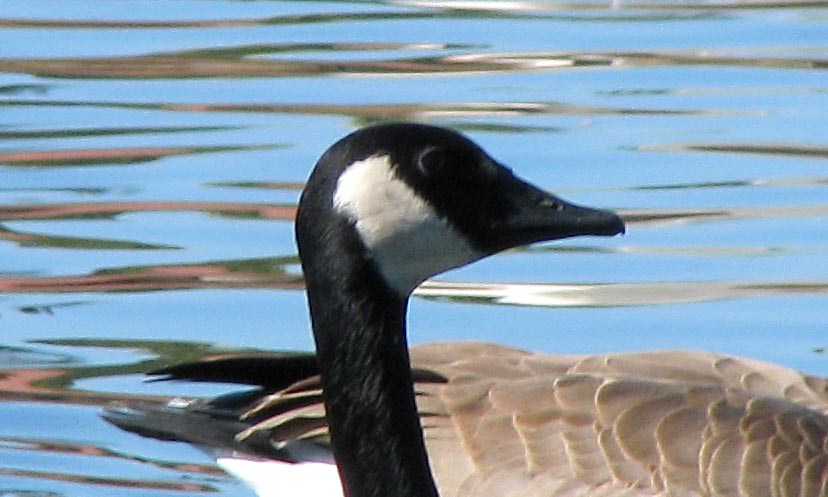 |
 |
|||||||||||||||||||||
|
||||||||||||||||||||||
Giant Canada Goose, Branta canadensis maxima, in Arizona
Pierre Deviche (deviche@asu.edu)
In 2004 the American Ornithologist’s Union officially split North American White-cheeked Geese into two species: Canada Goose, Branta canadensis and Cackling Goose, B. hutchinsii (Banks et al., 2004). The largest recognized subspecies of Canada Goose is the Giant Canada Goose, B. c. maxima (Fig. 1).

Figure 1. Amherst, MA; 26 Dec. 2006. Typical Giant Canada Goose (G) with smaller Canada Geese (B. c. canadensis and/or interior). Photo/J.P. Smith.
In the 1950s B. c. maxima was considered extinct. However, the discovery of isolated populations in Minnesota in the 1960s (Hanson, 1997) and the subsequent implementation of an intensive and successful reintroduction program along the Mississippi Valley Flyway and some western states (e.g., Colorado) have resulted in the Giant Canada Goose now being widespread and locally abundant, with an estimated 2005 population exceeding 1.5 million birds (Mowbray et al., 2002; U.S. Fish and Wildlife Service, 2005). Southern populations of B. c. maxima are sedentary whereas northern populations are migratory and winter mostly in the Tennessee and Mississippi valleys (Mlodinow et al., 2006; Mowbray et al., 2002).
There are few confirmed records of Giant Canada Goose in western states (e.g., Mlodinow et al., 2006). However, the continued population and range expansions of this subspecies make it likely that it will occur with increased frequency in the western U.S. Observers in Arizona where most Canada Geese belong to the moffitti (= Great Basin) subspecies should, therefore, recognize the differences separating B. c. moffitti from B. c. maxima.
On 22 Dec. 2007, J.P. Smith observed a large Canada Goose in a flock of B. c. moffitti at the Scottsdale Pavilions ponds (Maricopa Co., AZ; Fig. 2: Foreground bird). This bird presents characteristics consistent with B. c. maxima (see below) and may constitute the first documented record of this subspecies in Arizona.

Figure 2. Scottsdale Pavilions, Scottsdale, AZ; 22 Dec. 2007. Giant Canada Goose, B. c. maxima (foreground bird). Note pale breast and large white cheek patch extending to base of bill. Photo/J.P. Smith.
Here we present some ways to separate typical B. c. maxima and B. c. moffitti (Mlodinow et al., 2006; Mowbray et al., 2002). We emphasize that birds belonging to various Canada Goose subspecies can look very similar and in some cases interbreed (Mowbray et al., 2002), resulting in individuals showing intermediate characteristics (see below). Thus, only archetypical birds can be safely identified and identification must rely on a combination of characters. B. c. maxima and B. c. moffitti can be differentiated as follows:
- Size. B. c. maxima is, on average, larger (average body weight almost 5 kg) than B. c. moffitti (less than 4 kg). Note that both subspecies exhibit a wide range of individual variation in body mass. Thus, especially from a distance, the two subspecies can appear to be the same size (Fig. 3).

Figure 3. McCormick Ranch, Scottsdale AZ; 2 February 2008. Two Giant Canada Geese (G) swimming along with B. c. moffitti (M). On B. c. maxima, note large size, extensive white cheek patch, and pale forehead. Photo/P. Deviche.
- Proportions. B. c. maxima is longer-necked than B. c. moffitti. Neck length in White-cheeked Geese is best estimated in flying birds because when birds are on land or swimming, their apparent neck length can vary considerably depending on posture (relaxed or alert; see, e.g., http://www.azfo.org/gallery/CAGO_Scottsdale_2008.html ).
- Plumage color. On average, B. c. maxima has paler underparts (especially the breast, which looks almost white) than B. c. moffitti. This difference is accentuated by the fact in B. c. maxima that the black neck stocking appears not to come down as far on the front of the neck as in other geese, i.e., the white of the breast extends slightly more up the neck (Figs. 1-3). Even though the average color difference is quite distinct, caution must be exercised because plumage color in B. c. maxima and B. c. moffitti probably overlap completely (S. Mlodinow, personal communication).
- Head color and pattern.
-
B. c. maxima typically shows more exposed white on the cheeks than other forms (Figs. 1-3). The white patch in B. c. maxima extends higher up the cheeks and toward the crown than in other subspecies and in contrast to B. c. moffitti, this patch contacts the base of the bill.
-
Most B. c. maxima individuals have a white band on the forehead between the black crown and bill. It should be pointed out that B. c. moffitti and other Canada Goose subspecies as well as some Cackling Geese can have this band which, therefore, is in and by itself not diagnostic.
-
B. c. maxima has a proportionally larger and more massive bill than B. c. moffitti.
- Voice. B. c. maxima reportedly has a deeper voice than B. c. moffitti.
On 30 Dec. 2007 at McCormick Ranch (Scottsdale, AZ), P. Deviche observed a different large size Canada Goose than the individual seen at the same site by J.P. Smith on 22 Dec. 2007. This bird is noticeably larger and longer-necked than B. c. moffitti and has a whiter breast and pale underparts (Fig. 4: Swimming; Fig. 5: Flying). It also has a large white cheek patch and a pale forehead band (Fig. 6).

Figure 4. Scottsdale Pavilions, Scottsdale, AZ; 30 Dec. 2007. Large Canada Goose (foreground bird) next to a B. c. moffitti Canada Goose. The foreground bird shows characteristics that are partly consistent with B. c. maxima. Photo/P. Deviche.

Figure 5. Scottsdale Pavilions, Scottsdale, AZ; 30 Dec. 2007. Same bird as on Fig. 4 in flight with two B. c. moffitti (M). Note large size, long neck, and pale breast. Photo/P. Deviche.

Figure 6. Scottsdale Pavilions, Scottsdale, AZ; 30 Dec. 2007. Detail of the head of the foreground bird shown on Fig. 4. Note that the white cheek patch does not reach the base of the bill. Photo/P. Deviche.
The above features are consistent with the 30 Dec. 2007 goose being a B. c. maxima. However, the pale forehead band of this bird is poorly defined compared to that of typical Giant Canada Goose (compare Fig. 6 with Figs. 2 and 3). In addition, the white cheek patch of the 30 Dec. 2007 bird does not appear to contact the base of the bill as is typical of Giant Canada Goose. Therefore, this goose is an atypical B. c. maxima or perhaps an intergrade between this form and B. c. moffitti.
The origin of Giant Canada Geese in Arizona is unknown. No introduction program for this subspecies was ever implemented in the state (M. Rabe, AZ Game and Fish Department; personal communication) and local aviculturists apparently do not or at least rarely keep this form in captivity (J. Badman, personal communication). Thus, B. c. maxima in Arizona presumably are of wild origin, but it cannot be excluded that they descend from introduced out-of-state stocks.
Field observers in Arizona are encouraged to focus on the plumage and structural characteristics of large wintering Canada Geese they encounter and to document their sightings photographically. In doing so they have an opportunity to advance the understanding of the variability in these traits that exists within and between White-cheeked Goose subspecies. Detailed observations also offer the potential to increase knowledge of the geographic distribution of these birds and its changes over time.
Acknowledgements
The author is indebted to Troy Corman, Steve Mlodinow, Michael Moore, Kurt Radamaker, James P. Smith, and Mark Stevenson for valuable comments on early versions of this article.
References:
Banks, R.C., Cicero C., Dunn J.L., Kratter A.W., Rasmussen P.C., Remsen J.V., Rising J.D., and Stotz D.F. (2004). Forty-fifth supplement to the American Ornithologists’ Union Check-list of North American Birds. Auk 121:985-995.
Hanson, H.C. (1997). The Giant Canada Goose, rev. ed. Illinois Natural History Survey, Carbondale, Ill.
Mowbray, T.B., Ely C.R., Sedinger J.S., and Trost R.E. (2002). Canada Goose (Branta canadensis), The Birds of North America Online (A. Poole, Ed.). Ithaca: Cornell Lab of Ornithology.
Mlodinow S.G., Schonewald D., and Grandstrand D. (2006). Giant Canada Goose in Washington. Western Birds 37: 48-50.
Sibley D.A. (2004). Identification of Canada and Cackling Goose. http://www.sibleyguides.com/canada_cackling.htm
United States Fish and Wildlife Service (2005). Waterfowl Population Status, 2005. U.S. Dept. Interior, Washington, D.C.
Wilson A. (2005). Identification and range of subspecies within the (Greater) Canada and (Lesser Canada) Cackling Goose Complex (Branta canadensis & B. hutchinsii). http://www.oceanwanderers.com/CAGO.Subspecies.html
|
©2005
|
HOME | | | REPORT SIGHTINGS | | | PHOTOS | | | BIRDING | | | JOURNAL | | | ABOUT US | | | CHECKLISTS | | | AZ BIRD COMMITTEE | | | EVENTS | | | LINKS |